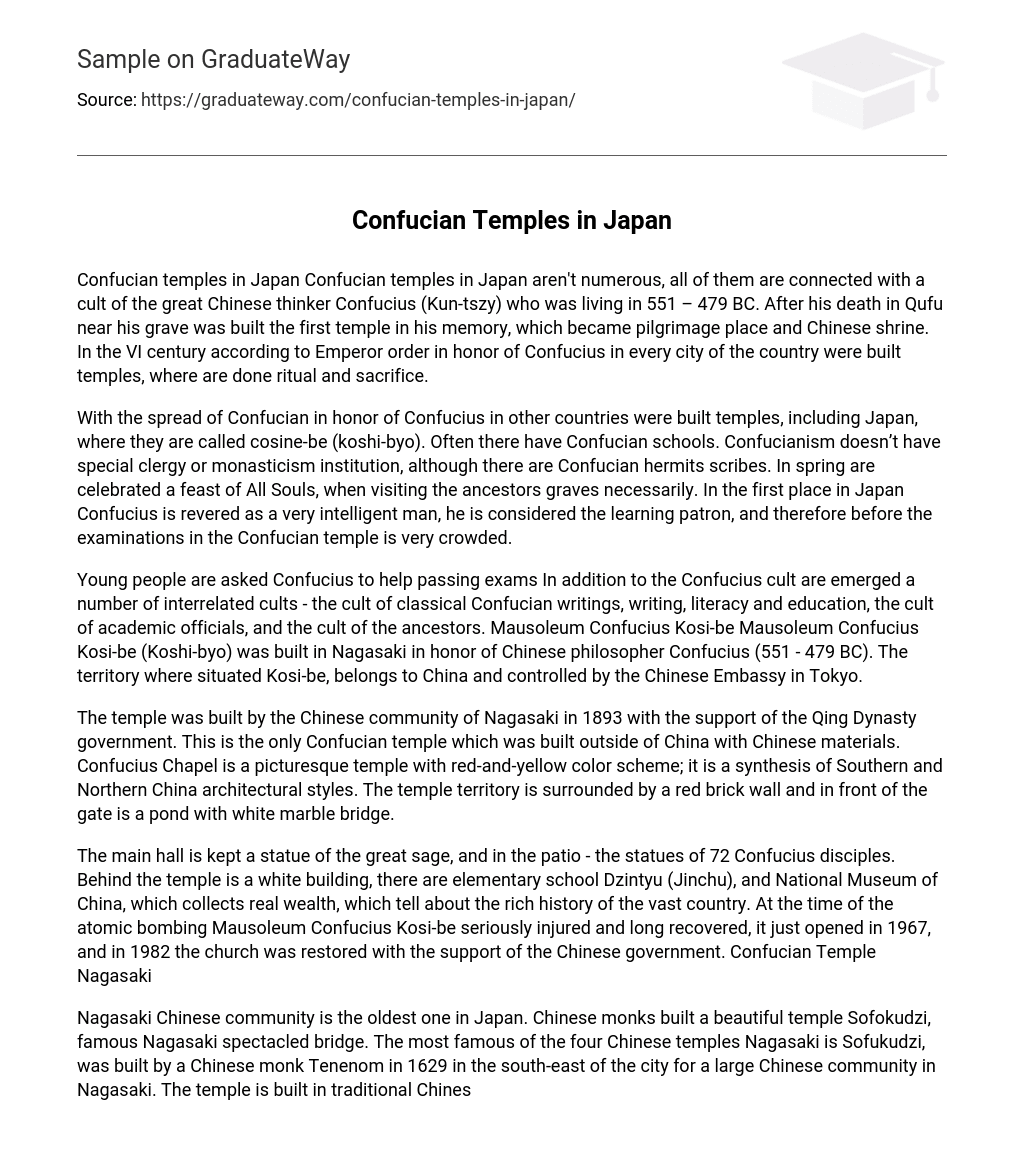Confucian temples in Japan Confucian temples in Japan aren’t numerous, all of them are connected with a cult of the great Chinese thinker Confucius (Kun-tszy) who was living in 551 – 479 BC. After his death in Qufu near his grave was built the first temple in his memory, which became pilgrimage place and Chinese shrine. In the VI century according to Emperor order in honor of Confucius in every city of the country were built temples, where are done ritual and sacrifice.
With the spread of Confucian in honor of Confucius in other countries were built temples, including Japan, where they are called cosine-be (koshi-byo). Often there have Confucian schools. Confucianism doesn’t have special clergy or monasticism institution, although there are Confucian hermits scribes. In spring are celebrated a feast of All Souls, when visiting the ancestors graves necessarily. In the first place in Japan Confucius is revered as a very intelligent man, he is considered the learning patron, and therefore before the examinations in the Confucian temple is very crowded.
Young people are asked Confucius to help passing exams In addition to the Confucius cult are emerged a number of interrelated cults – the cult of classical Confucian writings, writing, literacy and education, the cult of academic officials, and the cult of the ancestors. Mausoleum Confucius Kosi-be Mausoleum Confucius Kosi-be (Koshi-byo) was built in Nagasaki in honor of Chinese philosopher Confucius (551 – 479 BC). The territory where situated Kosi-be, belongs to China and controlled by the Chinese Embassy in Tokyo.
The temple was built by the Chinese community of Nagasaki in 1893 with the support of the Qing Dynasty government. This is the only Confucian temple which was built outside of China with Chinese materials. Confucius Chapel is a picturesque temple with red-and-yellow color scheme; it is a synthesis of Southern and Northern China architectural styles. The temple territory is surrounded by a red brick wall and in front of the gate is a pond with white marble bridge.
The main hall is kept a statue of the great sage, and in the patio – the statues of 72 Confucius disciples. Behind the temple is a white building, there are elementary school Dzintyu (Jinchu), and National Museum of China, which collects real wealth, which tell about the rich history of the vast country. At the time of the atomic bombing Mausoleum Confucius Kosi-be seriously injured and long recovered, it just opened in 1967, and in 1982 the church was restored with the support of the Chinese government. Confucian Temple Nagasaki
Nagasaki Chinese community is the oldest one in Japan. Chinese monks built a beautiful temple Sofokudzi, famous Nagasaki spectacled bridge. The most famous of the four Chinese temples Nagasaki is Sofukudzi, was built by a Chinese monk Tenenom in 1629 in the south-east of the city for a large Chinese community in Nagasaki. The temple is built in traditional Chinese architecture of the late period of the Ming Dynasty, which almost lost in South China. The main hall and the second gate are ranked as national treasures.
The Chinese and Japanese Chinese origin come here for the feast dead O-Bon, held from 26 to 28 July of the lunar calendar. Temple Fukusaydzi is the one of the four temples built by the Chinese in the 1620s. Across the Nakasimagava river is spanned famous bridge Megane-bashi. It is the oldest humpbacked stone bridge in Japan, it was built in 1634 by the Chinese monk from the temple Kofukudzi. Name of the bridge means “Spectacled bridge”, because his two arches reflected in the water like spectacles. Confucian Temple Yushima Seido
Confucian Temple Yushima Seido, shrine was founded by Tsunaesi Tokugawa’s shogun, in the Edo period here was the Academy Seheyko – first university in Japan. On the territory of Yusim Seido is a statue of the great Chinese philosopher Confucius. Near the Confucian temple located Hidziri-bashi Bridge over the River Kanda, on the other side of the bridge is the Orthodox Cathedral of St. Nicholas or just Nicholas-do church. Confucian Temple Taku Seibyo Taku is a small town with a population of 20,000 people in Saga Prefecture in the south-west of the Kyushu island.
Saga – the modern name, originally called the prefecture Hizen province, ruled by the daimyo (ruler) Nabeshima Mitsushige. His vassal named Taku Seibyo (1669 – 1711) rules in the village of Taku. The Samurai was an educated and respectable family man, who respects Confucius and in 1699 he opened the Confucian school. In 1708, Taku Seibyo supported his lord Nabeshima Mitsusige to built Confucian temple, which is now the national treasure of Japan. This is one of the oldest temples of Confucius in Japan.
Built in the Chinese-style, this architectural style typical for the Zen Buddhist temples. In the neighborhood is the statue of Confucius. The temple was ruled by several generations of the family Taku Seibyo. Twice a year, in spring and autumn there held festivals. The Japanese participate in action, dressed in Chinese costumes of the Ming Dynasty, plays music Gagaku, performed lion dance. The whole festival is very entertaining. This temple is visited by many tourists; it is called the most magnificent Confucius temple in the Land of the Rising Sun.





